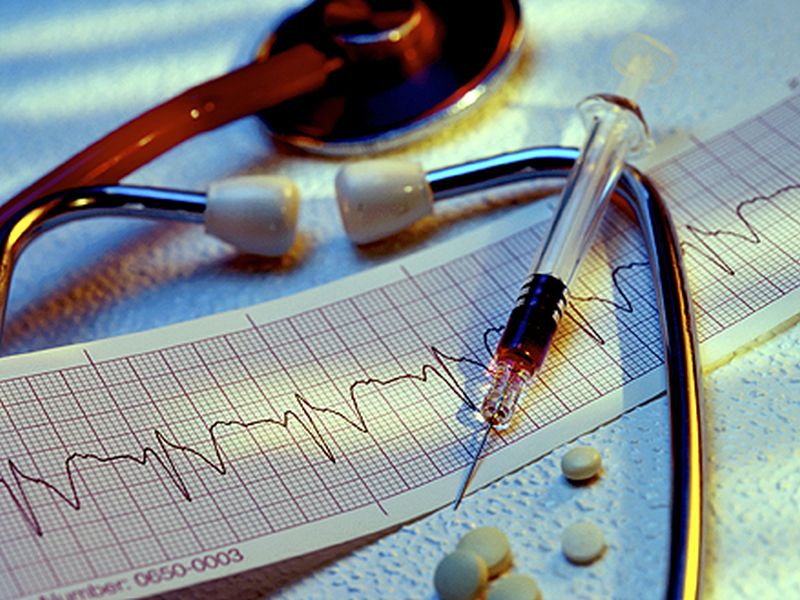- Navigating Your Midlife Crisis: Embracing New Possibilities
- City Raccoons Showing Signs of Domestication
- Mapping the Exposome: Science Broadens Focus to Environmental Disease Triggers
- One Week Less on Social Media Linked to Better Mental Health
- Your Brain Changes in Stages as You Age, Study Finds
- Some Suicide Victims Show No Typical Warning Signs, Study Finds
- ByHeart Formula Faces Lawsuits After Babies Sickened With Botulism
- Switch to Vegan Diet Could Cut Your Greenhouse Gas Emissions in Half
- Regular Bedtime Does Wonders for Blood Pressure
- Dining Alone Could Mean Worse Nutrition for Seniors
Angioplasty May Not Boost Survival for Some Heart Disease Patients


Angioplasty — the procedure used to open narrowed or blocked arteries — doesn’t seem to lengthen life for people with stable heart disease and chest pain, a new study finds.
After 15 years of follow-up, the study found that people who had angioplasty fared no better than those who had their heart disease treated with medication and lifestyle changes alone.
“[Angioplasty and] stenting is effective and improves survival when performed early in the course of a heart attack,” said lead researcher Dr. Steven Sedlis, an associate professor of medicine at NYU Medical School in New York City. “But the benefits of routine [angioplasty and] stenting for patients with stable heart disease have been uncertain and highly controversial.”
During the angioplasty procedure, a small tube may be placed in the blood vessel to keep it open. This is called stenting.
Routine angioplasty and stenting don’t improve long-term survival, and this study supports current guidelines that recommend medications first, Sedlis said. Angioplasty and stenting should be reserved for patients whose symptoms cannot be controlled by medications, he explained.
Co-author Dr. William Boden, a professor of medicine at Albany Medical College in Albany, N.Y., said, “We know that in heart attack patients, angioplasty can be lifesaving.”
But in patients with stable heart disease — even those with chest pain — medication and lifestyle changes (or “medical therapy”) may be the best way to minimize the risk of heart attacks and heart-related death, he said.
Boden explained that medical therapy includes drugs to lower blood pressure and cholesterol, and aspirin to reduce the risk of blood clots. In addition, patients may receive lifestyle counseling to help them quit smoking, and improve their weight through exercise and eating a healthy diet.
About one million angioplasties are done each year in the United States, and about 500,000 are done in patients with stable heart disease, Boden said.
Stable heart disease refers to chest pain that occurs in a predictable pattern, such as when you’ve been exercising for a certain period of time. Stable heart disease is usually relieved by rest or with medication, the American Heart Association (AHA) says. Unstable heart disease is unpredictable or surprising chest pain. It usually occurs when you’re resting. Unstable chest pain often leads to a heart attack, according to the AHA.
“Patients need to understand what they are getting an angioplasty for,” Boden said. “If they are being told that it’s going to reduce the risk of heart attack or it’s going make them live longer, they’re getting the wrong message.”
The report was published in the Nov. 12 issue of the New England Journal of Medicine.
For the study, researchers looked at the long-term survival of more than 1,200 patients who took part in the COURAGE trial (Clinical Outcomes Utilizing Revascularization and Aggressive Drug Evaluation).
In that trial, people were randomly assigned to have an angioplasty plus medication, or receive medical therapy alone to manage their heart disease and relieve their chest pain (angina).
During the 15-year follow-up, 561 patients died: 180 died during the initial four-year follow-up period in the original trial, and 381 died during the remaining follow-up period.
Among those who had undergone angioplasty, 284 people died. And 277 people died in the group treated with medical therapy alone, the researchers reported.
Dr. Gregg Fonarow, a spokesman for the American Heart Association, explained that “while angioplasty for patients with stable heart disease has often been perceived by patients and their doctors to reduce the risk of heart attacks and death, clinical trials have shown no such benefit compared with medical therapy alone.”
The findings of this study reinforce that the most effective way to prevent heart attacks and premature death in men and women with stable heart disease is medical therapy, including aspirin, ACE inhibitors, beta blockers and statins, along with lifestyle modification, added Fonarow, who is also a professor of cardiology at the University of California, Los Angeles.
“Angioplasty alone, while potentially reducing symptoms, provides no detectable benefit in terms of survival in patients with stable coronary artery disease,” he said.
More information
For more about angioplasty and other heart procedures, visit the American Heart Association.
Source: HealthDay
Copyright © 2025 HealthDay. All rights reserved.










